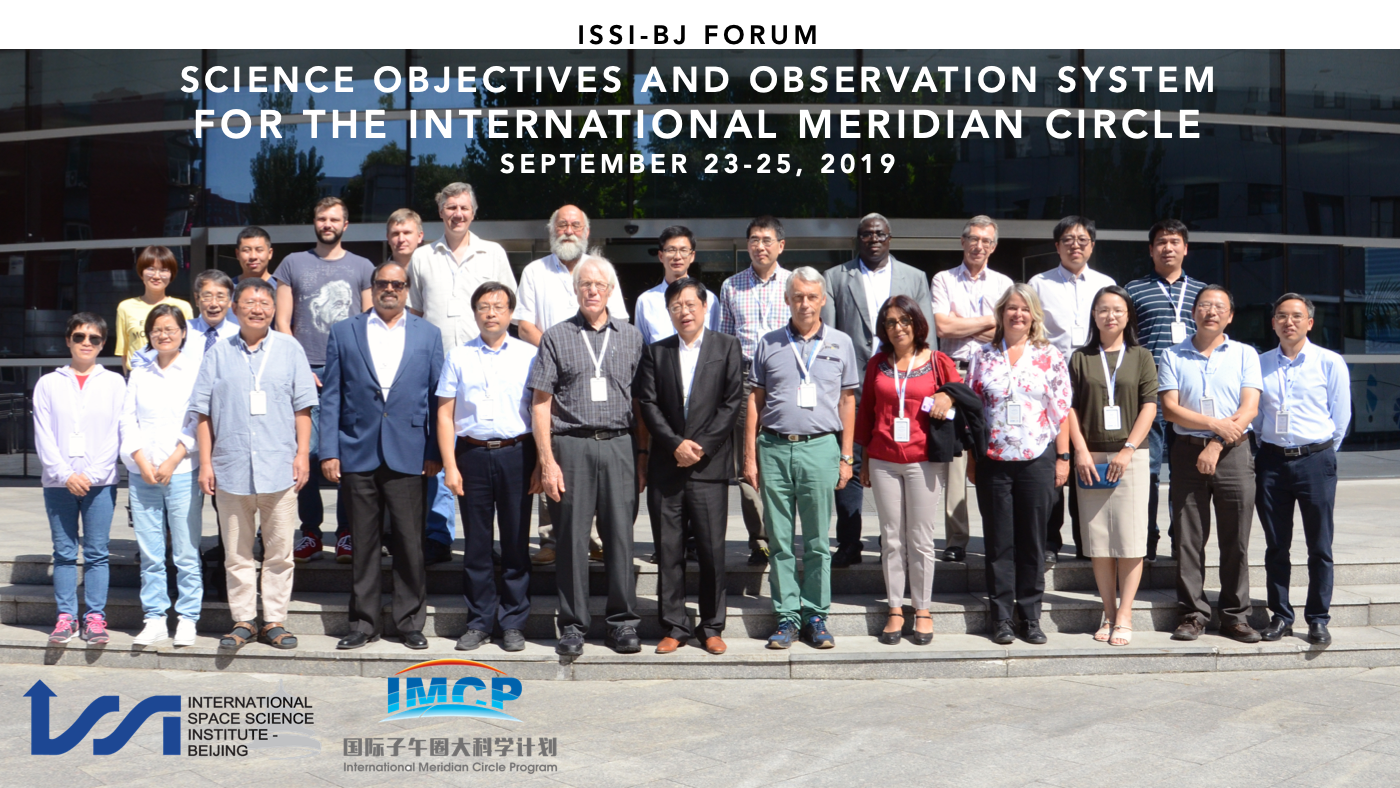BEIJING, CHINA — Numerous international renowned scientists gathered at the premises of the International Space Science Institute in Beijing (ISSI-BJ) on September 23-25, 2019 to attend the forum “Science Objectives and Observation System for the International Meridian Circle” organized by ISSI-BJ with the support of the International Meridian Circle Program (IMCP).
With Prof. William Liu (NSSC, CAS, China), Prof. Michel Blanc (IRAP, CNRS-Universit Toulouse III, France), Prof. Eric Donovan (University of Calgary, Canada), Prof. John C. Foster (MIT Haystack Observatory, USA), Prof. Mark Lester (University of Leicester, UK), and Prof. Maurizio Falanga (ISSI-BJ) as its conveners, the forum attracted ca. 30 several international leading personalities from different institutions and countries, including France, Morocco, Brazil, Spain, UK, Burkina Faso, Belgium, Japan, Nigeria, Russia, USA, and China.

Group photo of the forum participants
In the light of the great challenges posed to our planet and to humankind by our changing environment, the forum tackled the question of how energy from the sun and the earth affects our planet by analyzing the issue from a very specific scientific angle, i.e. the function of the Upper and Middle Atmosphere and Ionosphere layers (IMUA) as a ‘mirror’ of these environmental jeopardies.
In fact, as the effects of environmental threats are detectable on the IMUA, such screen represents an essential tool for the prediction, identification, and mitigation of possible natural disasters coming from above (Solar activity and Interplanetary Space) and from below (lower atmosphere, meteorology, climate change and Solid Earth).
For the purpose of controlling and tempering the negative consequences of environmental transformations, two main results were set as forum goals, i.e. providing a science case for the creation of an internationally-coordinated Observation System of the IMUA at global level, and identifying the preliminary ground-based design of such system, called the “International Meridian Circle Project” (IMCP). While the former specifically served for a significant improvement in the monitoring, understanding, and predicting of potential sources of dangers, the latter laid the groundwork for data analysis and modeling tools as well as for the subsequent Forum on an associated space segment.
To this end, the forum was organized into three major thematic sessions — Science Cases, Observation System, Modeling and Data Analysis/Assimilation Tools — spanning over three days. Following the principle of interdisciplinarity fostered by ISSI-BJ, during the first section held in the morning of September 23, the presenters touched multiple topics, such as “Solar and interplanetary processes” (Prof. Gopalswamy, NASA Goddard Space Flight Center, USA), “Magnetosphere processes” (Prof. Gonzalez, INPE, Brazil), and “Troposphere/stratosphere weather system” (Prof. Lu, Institute of Atmospheric Physics, CAS, China).
The completion of this initial session chaired by Prof. Lester (University of Leicester, UK) prompted all scientists to reflect and discuss on the above mentioned “Chinese Meridian Project” System (Prof. Xu, NSSC, CAS, China) as well as on the observations of the magnetosphere (Prof. Opgenoorth, University of Ume?, Sweden/University of Leicester, UK, ESF/ESSC), the ionosphere (Prof. Donovan, University of Calgary, Canada), the middle/upper atmosphere (Prof. Bounhir, University of Marrakech and Oukaimeden Observatory, Morocco), as well as on the solar and interplanetary monitoring (Prof. Yan, National Astronomical Observatories, CAS, China), among others.
With the beginning of the second day, the thematics of the session on the Modeling and Data Analysis/Assimilation tools were approached, going into the details of “MIT (Magnetosphere-Ionosphere-Thermosphere) coupling” (Prof. Zou, University of Michigan, USA), “ITM (Ionosphere-Thermosphere-Mesosphere) coupling” by Prof. Lei (University of Science and Technology of China, China) and “Plasmasphere Modeling” by Prof. Pierrard (Belgian Institute for Space Aeronomy, Brussels, Belgium), before moving to the Preliminary Synthesis of the forum.
This phase opened the general discussion and summary of the forum which took place in the morning of September 25, when participants also addressed the preparation of the Second IMCP-led Forum on the Space Segment.
To serve the purpose of involving the non-expert community, ISSI-BJ regularly releases a forum-related magazine, TAIKONG; the new issue based on the forum “Science Objectives and Observation System for the International Meridian Circle” will be published and distributed to the science communities and space science institutions in the following months, and it will also be made available on the ISSI-BJ website.
The speakers’ presentations can be downloaded from the “Agenda” section on the forum webpage.
For more information, please contact ISSI-BJ PR and Editorial Manager Laura Baldis: laura.baldis@issibj.ac.cn